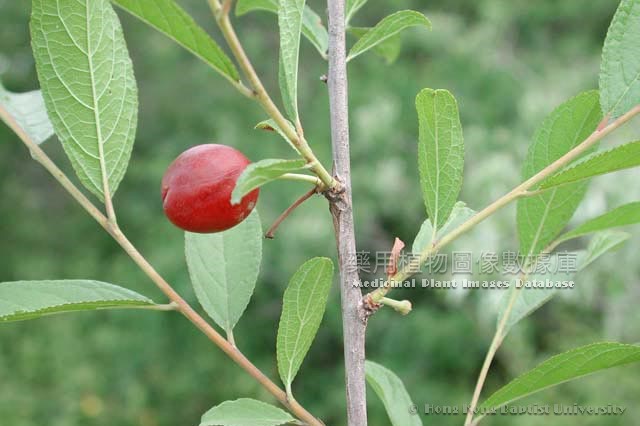|
|
|
Prunus humilis Bge.

|
English Name |
Chinese Dwarf Cherry, Bunge Cherry, China Dwarf Cherry |
|
Latin name |
Prunus humilis Bge. |
|
Family & Genus |
Rosaceae, Prunus |
|
Description |
Deciduous shrub, 0.4-1.5m high. Much branched, branchlets greyish brown or brown, pubescent. Leaves alternate; petiole short, about 2mm, glabrous or sparsely pubescent; stipules linear, 5-6mm long, margin glandular, caducous; leaf blade oblong obovate or elliptic, 1.5-5cm long, about 2cm wide, above middle part the widest, apex acute or short acuminate, base cuneate, margin shallow serrulate, both sides smooth, or sparsely pubescent along main veins on the back of leaf surface. Leaves and flowers blooming at the same time, solitary or 2 flowers inserted in leaf axils; pedicel ca. 1cm long, sparsely pubescent; calyx tube campanulate, glabrous or sparsely pubescent, lobes long ovate, flower reflexed backward; Petals white or pink, with deep identical-coloured reticulate, oblong or obovate; stamens numerous, anther oblong to broadly linear, filaments unequal in length; pistil 1, carpel 1, style and stamen nearly equal in length, glabrous. Drupe subglobose, red or purple red, the diameter 1.5-1.8cm; No prismatic pattern except for both back sides on the core surface. Flowering: April to May, fruiting: June to October. |
|
Distribution |
Growing on sunny slopes and sandy lands at altitude 100-1,800m, or thickets. Can be cultivated. Distributed in Northeast China, Inner Mongolia, Hebei, Shandong, Henan and etc. The medicinal materials are mainly produced in Hebei, Inner Mongolia, Liaoning, Shandong and etc. |
|
Part Used |
Medical part: mature seeds. Chinese name: Yuliren. |
|
Harvest & Processing |
Harvested mature fruits in summer and autumn, removed the flesh and the shell, taken out the seeds, and dried. |
|
Chemistry |
Seeds contain amaygdalin 2.25%, and Prunuside A, B. |
|
Pharmacology |
Purgative, anti-inflammatory and pain-killing. |
|
Properties & Actions |
Bitter, sweet, neutral bitter, sweet, neutral.Moistening dryness and smoothing the bowels, depressing qi and disinhibiting diuresis. |
|
Indications & Usage |
Syndrome of intestinal dryness and fluid depletion, food acumulation and qi stagnation, abdominal distention and constipation, edema, beriberi, inhibited urination.Internal: decocting, 3-10g; or made as pills or powders. Patients with spleen deficiency or diarrhea should avoid any intake. Use with caution in case of pregnancy. |
|
Examples |
1. Abdominal distention with inhibited urination: gansui spurge 15g, equal amount of orange peel, dwarf flowering cherry seed, betel nut, tuckahoo, baizhu, 30g. Powered. Take 6g each time with boiled ginger and jujube water.
2. Blood in sweat: Powered dwarf flowering cherry seed, 3g each time with pear juice. |
| Link to |
 Chinese Medicinal Material Images Database Chinese Medicinal Material Images Database
 Chinese Medicine Specimen Database Chinese Medicine Specimen Database
|
|
Permanent URL:https://sys01.lib.hkbu.edu.hk/cmed/mpid/detail.php?herb_id=D00101 |
|
|
|

